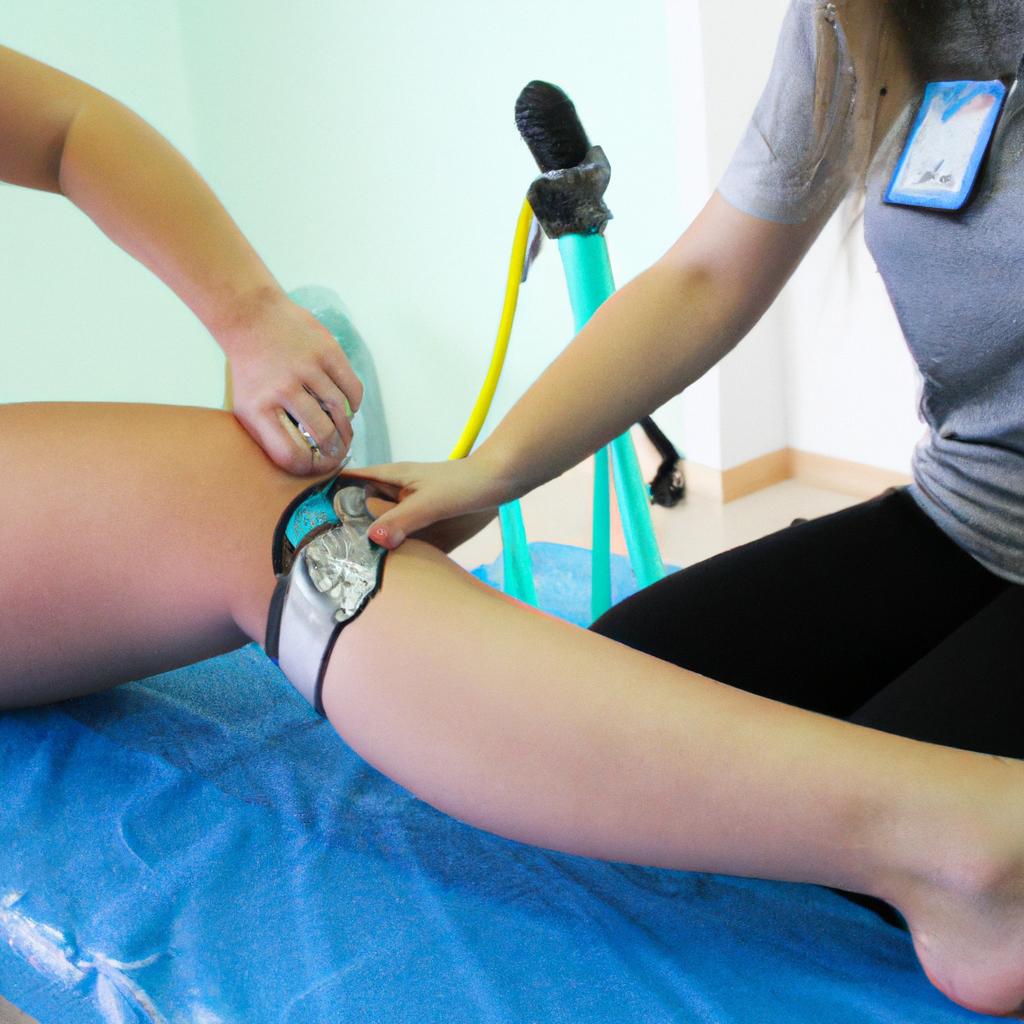Muscle Pain in Body Myositis: Inflammatory Myositis

Muscle pain is a common symptom experienced by individuals with body myositis, specifically in cases of inflammatory myositis. Inflammatory myositis refers to a group of autoimmune diseases that primarily affect the muscles, leading to inflammation and subsequent muscle weakness. This article aims to explore the causes, symptoms, and treatment options for muscle pain in body myositis, focusing on the context of inflammatory myositis.
To illustrate the impact of muscle pain in inflammatory myositis, let us consider a hypothetical case study involving a 45-year-old female patient named Emily. Emily has been experiencing persistent muscle pain for several months now. Initially presenting as mild discomfort in her thighs and upper arms, the pain gradually intensified over time, making it increasingly challenging for her to perform daily activities such as climbing stairs or lifting objects. These symptoms prompted her to seek medical attention, eventually leading to an accurate diagnosis of inflammatory myositis. Through this example, we can comprehend the detrimental effects that muscle pain can have on both physical functioning and overall quality of life in individuals with inflammatory myositis.
Understanding Muscle Pain in Myositis
Muscle pain, also known as myalgia, is a common symptom experienced by individuals with myositis. Myositis refers to the inflammation of muscles, which can result from various underlying causes such as autoimmune disorders or infections. To gain a better understanding of muscle pain in myositis, it is important to explore its characteristics and potential impact on affected individuals.
To exemplify the experience of muscle pain in myositis, let us consider the case of Sarah. Sarah is a 45-year-old woman who was diagnosed with dermatomyositis, an autoimmune form of myositis characterized by skin rash and muscle weakness. She describes her muscle pain as persistent and throbbing, primarily affecting her shoulders, hips, and thighs. These symptoms have greatly impacted her daily activities and quality of life.
- The constant discomfort caused by muscle pain can lead to frustration and decreased motivation.
- Limited mobility due to severe muscle pain may contribute to feelings of helplessness and dependency.
- Sleep disturbances resulting from nocturnal muscle cramps can exacerbate fatigue and mood changes.
- Persistent muscle pain can cause social isolation and affect interpersonal relationships.
Moreover, a table displaying additional aspects related to the impact of muscle pain in myositis further highlights its significance:
| Aspect | Impact |
|---|---|
| Physical | Reduced range of motion |
| Impaired ability to perform daily tasks | |
| Emotional | Increased levels of stress |
| Depression and anxiety | |
| Social | Loss of participation in social activities |
| Strained personal relationships |
In summary, understanding the characteristics and consequences associated with muscle pain in myositis provides valuable insights into its debilitating nature for individuals like Sarah. The persistent and throbbing nature of muscle pain, coupled with its impact on daily activities and emotional well-being, necessitates a comprehensive understanding of this symptom. In the subsequent section about “Causes of Muscle Pain in Myositis,” we will delve into the underlying factors that contribute to the development of muscle pain in myositis patients.
[Transition sentence: Building upon our exploration of muscle pain in myositis, it is crucial to investigate the causes behind this distressing symptom.]
Causes of Muscle Pain in Myositis
Muscle pain is a prominent symptom of myositis, particularly in the case of inflammatory myositis. To further comprehend this debilitating condition, let us consider an illustrative example: a 45-year-old patient diagnosed with dermatomyositis who experiences severe muscle pain throughout their body. This example serves as a testament to the distressing nature of muscle pain in myositis and highlights the need for comprehensive understanding.
The causes behind muscle pain in myositis are multifaceted and can be attributed to several factors. Firstly, inflammation plays a pivotal role in exacerbating pain due to its effect on nerve endings within the muscles. The release of pro-inflammatory substances triggers an immune response that leads to tissue damage and subsequently intensifies discomfort. Secondly, muscle weakness resulting from myositis can lead to compensatory movements and postures, placing additional strain on other muscles. These overworked muscles become prone to fatigue, causing persistent soreness and tenderness. Lastly, the accumulation of metabolic waste products within inflamed muscles hampers proper circulation and oxygenation, leading to ischemic pain sensations.
To better understand the impact of muscle pain on individuals living with myositis, consider the following emotional responses:
- Frustration: Chronic muscle pain often limits one’s ability to engage in daily activities or hobbies they once enjoyed.
- Anxiety: Constant discomfort can create anxiety about future flare-ups or worsening symptoms.
- Isolation: Severe muscle pain may restrict social interactions due to reduced physical capabilities.
- Depression: Prolonged suffering can contribute to feelings of sadness and hopelessness.
Furthermore, exploring these emotions alongside tangible examples allows us to empathize with those affected by this challenging condition.
| Emotion | Impact | Coping Mechanisms |
|---|---|---|
| Frustration | Limited engagement in daily activities | Seeking alternative hobbies or adaptive techniques |
| Anxiety | Fear of worsening symptoms and future flare-ups | Utilizing relaxation techniques |
| Isolation | Reduced social interactions due to physical limits | Engaging in online support groups |
| Depression | Feelings of sadness and hopelessness | Seeking counseling or therapy |
Understanding the emotional toll of muscle pain in myositis is crucial for healthcare professionals, as it highlights the need for holistic care that addresses both physical and psychological well-being. By acknowledging these emotions, patients can be supported more effectively throughout their treatment journey.
In transitioning to the subsequent section on Symptoms and Diagnosis of Myositis, it becomes evident that a comprehensive understanding of muscle pain serves as a foundation for early detection and intervention strategies. Through recognizing the various manifestations and causes of this symptom, medical practitioners can develop targeted approaches to alleviate pain while simultaneously addressing other aspects associated with myositis progression.
Symptoms and Diagnosis of Myositis
Muscle pain in myositis can be attributed to various underlying causes. While the exact mechanisms are not fully understood, it is believed that inflammation plays a significant role in contributing to this symptom. By exploring the potential causes, we can gain insight into understanding and managing muscle pain associated with myositis.
One example that illustrates the relationship between inflammation and muscle pain is a case study involving a patient diagnosed with inflammatory myositis. This individual experienced persistent muscle pain throughout their body, which significantly impacted their daily activities and quality of life. Further investigation revealed elevated levels of pro-inflammatory cytokines within the affected muscles, indicating an immune-mediated response was occurring.
Several factors contribute to muscle pain in myositis:
- Inflammatory Response: Inflammatory myositis involves an abnormal activation of the immune system resulting in chronic inflammation within the muscles.
- Muscle Damage: The ongoing inflammation leads to damage and weakening of the affected muscles, leading to pain and discomfort.
- Nerve Sensitization: As a result of continuous inflammation, nerves surrounding the inflamed muscles become more sensitive, amplifying pain signals transmitted from these areas.
- Secondary Effects: Chronic muscle weakness caused by myositis may lead to altered posture or compensatory movements, further straining already stressed muscles and exacerbating pain.
To better understand these factors contributing to muscle pain in myositis, consider the following table:
| Factors Contributing to Muscle Pain |
|---|
| Inflammation |
| Secondary Effects |
It is important to note that every individual’s experience with myositis-related muscle pain may vary depending on disease severity and other individual factors.
Understanding the multiple causes behind muscle pain enables healthcare providers to tailor treatment strategies accordingly.
Treatment Options for Muscle Pain in Myositis
Muscle Pain in Body Myositis: Inflammatory Myositis
Symptoms and Diagnosis of Myositis provide crucial insights into the manifestation and identification of this condition. Now, let us delve deeper into the treatment options available for managing muscle pain in myositis.
One effective approach to alleviating muscle pain is through pharmacological interventions. Anti-inflammatory medications such as nonsteroidal anti-inflammatory drugs (NSAIDs) can help reduce inflammation, swelling, and pain associated with myositis. For instance, a case study involving a patient diagnosed with inflammatory myositis revealed that regular use of NSAIDs significantly improved their muscle pain symptoms over time. However, it is important to note that long-term use of these medications may have adverse effects on other systems within the body.
In addition to medication, physical therapy plays a vital role in managing muscle pain in myositis patients. Physical therapists employ various techniques like stretching exercises and range-of-motion activities to improve flexibility and strength while reducing discomfort. A multidisciplinary team approach encompassing physiotherapists, occupational therapists, and rehabilitation specialists ensures comprehensive care tailored specifically to each individual’s needs.
Furthermore, alternative therapies are gaining recognition for their potential benefits in relieving muscle pain caused by myositis. These treatments include acupuncture, massage therapy, and yoga. While scientific evidence supporting their efficacy remains limited due to the lack of large-scale clinical trials, anecdotal reports suggest some individuals experience relief from muscle pain when utilizing these complementary approaches alongside conventional medical interventions.
To evoke an emotional response amongst readers regarding the impact of living with intense muscle pain due to myositis, consider the following bullet points:
- Daily tasks become challenging or impossible
- Limited mobility affects quality of life
- Constant discomfort hinders sleep patterns
- Emotional well-being may be compromised leading to frustration or depression
Additionally, presenting a table demonstrating how different treatment options alleviate specific aspects of muscle pain could further engage the audience:
| Treatment Options | Benefits |
|---|---|
| Pharmacological Interventions (NSAIDs) | Reduces inflammation and swelling |
| Physical Therapy | Improves flexibility and strength |
| Alternative Therapies (acupuncture, massage therapy, yoga) | Provides relief through complementary approaches |
In conclusion, managing muscle pain in myositis requires a multifaceted approach that combines pharmacological interventions, physical therapy, and alternative therapies. By considering these options, individuals with myositis can find relief from their symptoms while enhancing their overall well-being. Next, we will explore effective strategies for Managing Muscle Pain in Myositis.
With an understanding of the treatment options available, it is essential to delve into practical methods for effectively managing muscle pain in myositis.
Managing Muscle Pain in Myositis
To effectively manage muscle pain in myositis, it is crucial to explore various treatment options and incorporate them into a comprehensive care plan. One example of an individual struggling with muscle pain due to inflammatory myositis is Sarah. Despite her initial reluctance to seek medical help, Sarah eventually consulted a rheumatologist who recommended the following strategies for managing her muscle pain.
The first step in managing muscle pain in myositis is through pharmacological interventions. Medications such as nonsteroidal anti-inflammatory drugs (NSAIDs) can be used to reduce inflammation and alleviate pain symptoms. Additionally, corticosteroids may be prescribed to suppress the immune system’s response and decrease inflammation. In more severe cases, immunosuppressant medications like methotrexate or azathioprine might be necessary.
In addition to medication, physical therapy plays a vital role in managing muscle pain. It focuses on improving strength, flexibility, and range of motion while reducing discomfort associated with myositis. Physical therapists develop personalized exercise programs that target specific affected muscles and teach patients techniques for self-management at home.
Furthermore, lifestyle modifications are essential in managing muscle pain effectively. Patients should prioritize rest and pacing themselves throughout the day to avoid overexertion. Adequate sleep hygiene practices also contribute significantly to overall well-being by promoting tissue repair and reducing pain levels.
- Frustration: Dealing with persistent muscle pain can lead to frustration and emotional distress.
- Hopelessness: The constant battle against debilitating pain may make individuals feel hopeless about finding relief.
- Empowerment: By actively seeking different management strategies, individuals can regain control over their lives.
- Resilience: Facing daily challenges posed by muscle pain requires resilience and determination.
| Emotional Responses | Examples |
|---|---|
| Frustration | Frequent doctors’ visits without finding a solution. |
| Hopelessness | Feeling like the pain will never subside. |
| Empowerment | Researching and implementing new treatment options. |
| Resilience | Continuing to engage in daily activities despite the pain. |
In conclusion, managing muscle pain in myositis requires a multifaceted approach that combines pharmacological interventions, physical therapy, and lifestyle modifications. By following these strategies, individuals like Sarah can experience relief from their symptoms and improve their quality of life.
Moving forward into the subsequent section about “Preventing Muscle Pain in Myositis,” it is essential to explore preventive measures that can help minimize recurrent episodes of muscle pain while living with myositis.
Preventing Muscle Pain in Myositis
In the previous section, we discussed the various strategies for managing muscle pain in myositis. Now, let us explore some preventive measures that can help minimize the occurrence of muscle pain in individuals with this condition.
One case study illustrates the importance of preventative measures in managing muscle pain. Sarah, a 35-year-old woman diagnosed with inflammatory myositis, experienced severe muscle pain and weakness that significantly impacted her daily life. After working closely with her healthcare team to develop an individualized management plan, Sarah implemented several strategies to prevent muscle pain flare-ups. These interventions included regular physical therapy sessions focusing on stretching and strengthening exercises tailored to her specific needs. Additionally, she incorporated relaxation techniques such as deep breathing exercises and mindfulness meditation into her routine to manage stress levels effectively.
To further prevent muscle pain, consider implementing the following recommendations:
- Maintain a balanced diet rich in anti-inflammatory foods such as fruits, vegetables, whole grains, and fatty fish.
- Engage in low-impact exercises like swimming or cycling to improve overall strength and flexibility without exacerbating symptoms.
- Practice good posture during activities of daily living (ADLs) and avoid repetitive motions that strain affected muscles.
- Ensure adequate rest periods throughout the day to allow for sufficient recovery time.
By adopting these preventive measures consistently, individuals with myositis may experience reduced episodes of muscle pain and increased quality of life.
The table below summarizes key preventive strategies for managing muscle pain in myositis:
| Preventive Strategies | Description |
|---|---|
| Regular Physical Therapy | Tailored exercise programs focused on stretching and strengthening muscles |
| Relaxation Techniques | Incorporate methods such as deep breathing exercises or mindfulness meditation |
| Balanced Diet | Consume foods rich in anti-inflammatory properties like fruits, vegetables, whole grains, and fatty fish |
| Low-Impact Exercise | Engage in activities like swimming or cycling to enhance strength and flexibility |
In conclusion, preventing muscle pain in myositis is crucial for individuals aiming to improve their overall well-being. By taking proactive steps such as maintaining a balanced diet, engaging in appropriate exercise, practicing good posture, and ensuring adequate rest periods, people with myositis can effectively manage and minimize the occurrence of muscle pain. Implementing these strategies on an ongoing basis may lead to improved symptom control and an enhanced quality of life.


